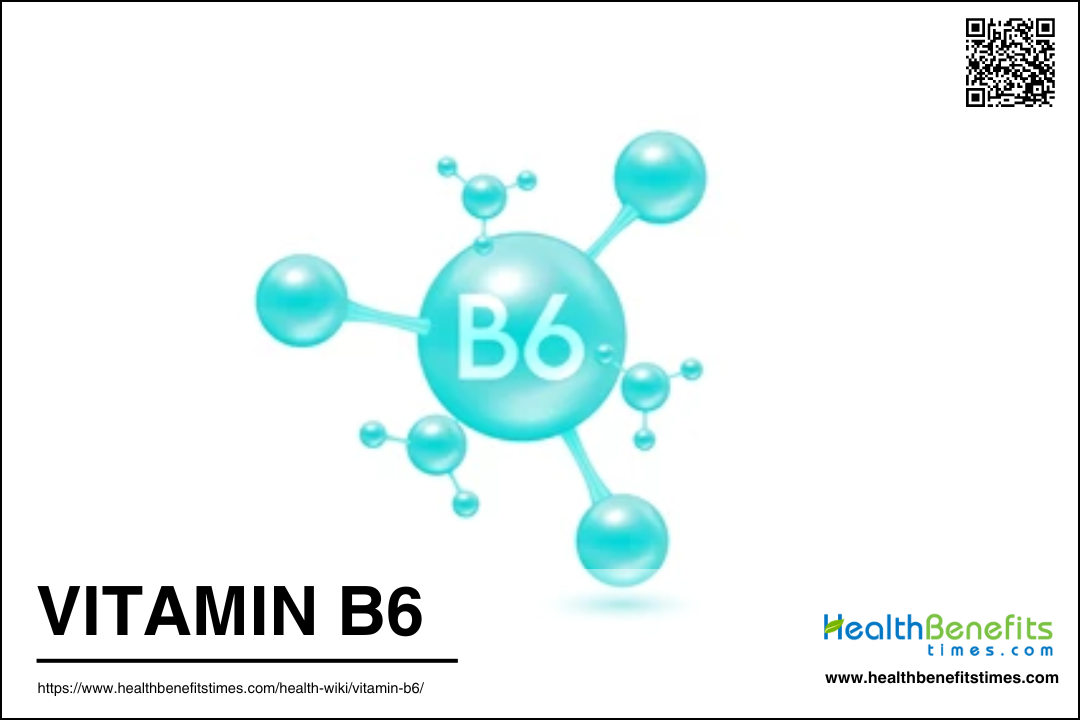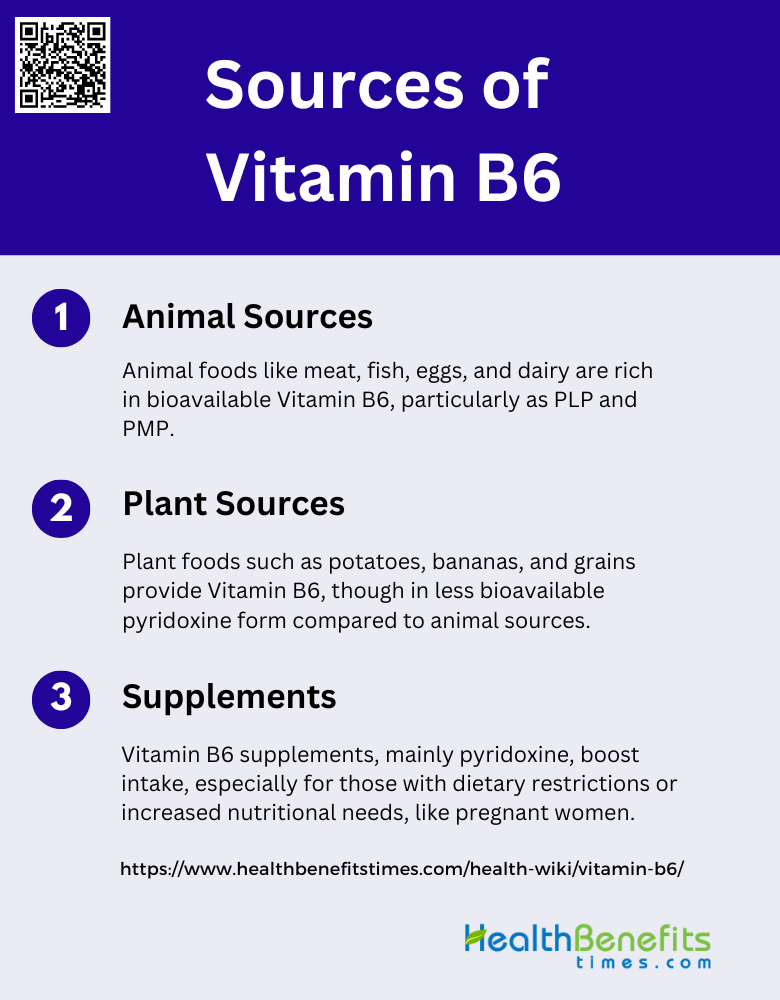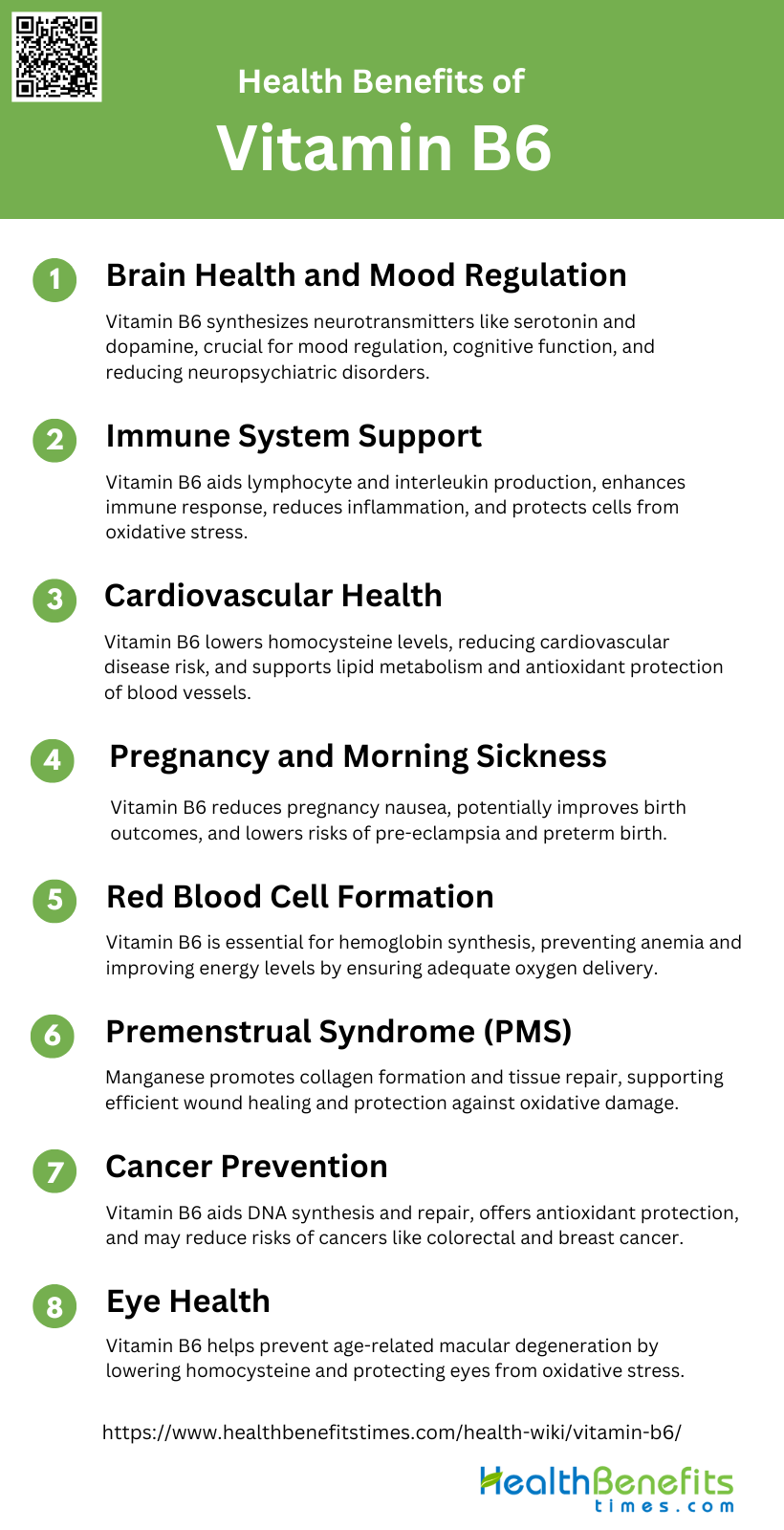Vitamin B6, also known as pyridoxine, is a water-soluble vitamin that plays a crucial role in numerous physiological processes within the human body. It exists in several forms, with pyridoxal 5′-phosphate (PLP) being the main active coenzyme in animal tissues. Vitamin B6 is involved in more than 160 enzymatic reactions, particularly in the metabolism of amino acids, carbohydrates, lipids, and neurotransmitters. This versatile nutrient is essential for protein synthesis, glucose and lipid metabolism, DNA/RNA synthesis, and can even act as a modulator of gene expression. Vitamin B6 is also critical for maintaining proper cognitive function, cardiovascular health, and immune system responses. While overt vitamin B6 deficiency is relatively rare in the general population, subclinical deficiencies may occur, especially in elderly individuals, potentially contributing to various health issues. As a key player in one-carbon metabolism, vitamin B6 interacts with other B vitamins like folate, vitamin B12, and riboflavin, highlighting its importance in overall cellular function and metabolism.
Sources of Vitamin B6
Vitamin B6, also known as pyridoxine, is an essential nutrient that plays a crucial role in various bodily functions. It aids in the metabolism of proteins, fats, and carbohydrates, and is vital for the proper functioning of the nervous and immune systems. Here are some common sources of Vitamin B6:
1. Animal Sources
Common animal sources include meat, fish, eggs, and dairy products. For instance, beef steaks and roasts, fish, and milk are notable contributors to dietary vitamin B6 intake. The bioavailability of vitamin B6 from animal sources is generally higher compared to plant sources, with precaecal digestibility ranging from 51% to 91% in different animal products. Additionally, the primary forms of vitamin B6 in meats are pyridoxal 5′-phosphate (PLP) and pyridoxamine 5′-phosphate (PMP), which are more bioavailable than the forms found in plants. This makes animal-based foods a reliable source of vitamin B6 for meeting daily nutritional requirements.
2. Plant Sources
Plants are also important sources of vitamin B6, although the bioavailability of the vitamin from plant sources is generally lower than from animal sources. Common plant-based sources include potatoes, bananas, soybeans, and various grains such as barley and wheat bran. The primary form of vitamin B6 in plants is pyridoxine, which is less bioavailable compared to the forms found in animal products. Despite this, plants remain a crucial source of vitamin B6, especially for vegetarians and vegans. Strategies such as biofortification have been explored to increase the vitamin B6 content in crops, thereby improving their nutritional quality and stress tolerance. Overall, while plant sources provide a significant portion of dietary vitamin B6, their lower bioavailability necessitates a varied diet to meet daily requirements.
3. Supplements
Vitamin B6 supplements are widely available and are often included in multivitamin preparations for both adults and children. These supplements typically contain pyridoxine, the most common form of vitamin B6, which is also the dominant form found in plant sources. The use of vitamin B6 supplements has been shown to be a strong predictor of vitamin B6 status, often more so than dietary intake alone. Supplements can be particularly beneficial for individuals with dietary restrictions or increased nutritional needs, such as pregnant and breastfeeding women, who have higher recommended daily allowances for vitamin B6. Additionally, supplements can help mitigate the risk of vitamin B6 deficiency in populations with limited access to diverse food sources.
Health benefits of Vitamin B6
Vitamin B6 is a vital nutrient that supports numerous bodily functions. It is essential for brain development, immune function, and the production of neurotransmitters. Here are some key health benefits of Vitamin B6:
1. Brain Health and Mood Regulation
Vitamin B6 plays a crucial role in brain health and mood regulation. It is involved in the synthesis of neurotransmitters such as serotonin, dopamine, and gamma-aminobutyric acid (GABA), which are essential for mood regulation and cognitive function. Deficiency in vitamin B6 has been linked to neuropsychiatric disorders, including depression, seizures, and chronic pain. Additionally, supplementation with vitamin B6 has been shown to reduce blood homocysteine levels, a risk factor for cerebrovascular disease and cognitive decline.
2. Immune System Support
It is involved in the production of lymphocytes and interleukins, which are critical components of the immune response. Deficiency in vitamin B6 can impair immune function, making the body more susceptible to infections and diseases. Studies have shown that adequate levels of vitamin B6 can enhance the immune response and reduce inflammation. This vitamin’s antioxidant properties also help in protecting cells from oxidative stress, further supporting immune health.
3. Cardiovascular Health
Vitamin B6 contributes to cardiovascular health by regulating homocysteine levels in the blood. Elevated homocysteine is a known risk factor for cardiovascular diseases, including heart disease and stroke. Supplementation with vitamin B6 has been shown to lower homocysteine levels, thereby reducing the risk of cardiovascular events. Additionally, vitamin B6’s role in lipid metabolism and its antioxidant properties further support cardiovascular health by preventing oxidative damage to blood vessels.
4. Pregnancy and Morning Sickness
Vitamin B6 is particularly beneficial during pregnancy. It helps in reducing nausea and vomiting, commonly known as morning sickness, which affects many pregnant women. Studies have also suggested that vitamin B6 supplementation can improve birth outcomes, such as higher birth weights and reduced risk of pre-eclampsia and preterm birth. However, more research is needed to confirm these benefits and to establish optimal dosing guidelines.
5. Red Blood Cell Formation
Vitamin B6 is vital for the formation of red blood cells. It is involved in the synthesis of hemoglobin, the protein in red blood cells that carries oxygen throughout the body. Deficiency in vitamin B6 can lead to anemia, characterized by fatigue and weakness due to insufficient oxygen delivery to tissues. Supplementation with vitamin B6 can help in the treatment of certain types of anemia, improving overall energy levels and well-being.
6. Premenstrual Syndrome (PMS)
Vitamin B6 has been shown to alleviate symptoms of premenstrual syndrome (PMS), including mood swings, irritability, and bloating. Studies have demonstrated that vitamin B6 supplementation can significantly reduce the severity of PMS symptoms, making it a valuable treatment option for many women. The vitamin’s role in neurotransmitter synthesis and hormonal regulation is believed to contribute to its effectiveness in managing PMS.
7. Cancer Prevention
Vitamin B6 may play a role in cancer prevention. Its involvement in DNA synthesis and repair, as well as its antioxidant properties, help protect cells from mutations and oxidative damage that can lead to cancer. Some studies have suggested that adequate intake of vitamin B6 is associated with a reduced risk of certain types of cancer, including colorectal and breast cancer. However, more research is needed to fully understand the mechanisms and to establish definitive recommendations.
8. Eye Health
Vitamin B6 is important for maintaining eye health. It helps in the prevention of eye diseases such as age-related macular degeneration (AMD) by reducing homocysteine levels, which can damage the blood vessels in the eyes. Additionally, its antioxidant properties protect the eyes from oxidative stress, which is a contributing factor to various eye conditions. Ensuring adequate intake of vitamin B6 can therefore support long-term eye health and vision.
Vitamin B6 Deficiency
Vitamin B6 deficiency can have significant health implications due to its role as a coenzyme in over 150 biochemical reactions, including amino acid metabolism, neurotransmitter production, and DNA/RNA synthesis. Deficiency in this vitamin is linked to various neuropsychiatric disorders such as seizures, migraines, chronic pain, and depression, and it may contribute to cognitive decline and dementia in older adults. Additionally, vitamin B6 deficiency can impair immune function, affecting both humoral and cell-mediated responses, which may influence tumor growth and disease processes. In elderly populations, vitamin B6 deficiency is prevalent and associated with malnutrition, inactivity, and elevated homocysteine levels, which can increase the risk of cardiovascular diseases.
Symptoms of Vitamin B6 Deficiency
Vitamin B6 deficiency can manifest through a variety of symptoms, impacting both physical and mental health. Clinically evident symptoms include impaired cognitive function, seizures, hyperirritability, and hyperacousis, particularly in infants. In adults, deficiency is associated with neuropsychiatric disorders such as depression, chronic pain, and migraines. Additionally, elderly individuals with vitamin B6 deficiency may experience impaired cognitive function, Alzheimer’s disease, and cardiovascular issues due to elevated homocysteine levels. Other symptoms include slow growth, depressed appetite, and inefficient food utilization, as observed in animal studies.
Causes of Vitamin B6 Deficiency
Vitamin B6 deficiency can be caused by several factors, including inadequate dietary intake, malabsorption, and increased metabolic demand. Elderly individuals are particularly at risk due to poor dietary habits and decreased absorption efficiency. Certain medical conditions, such as chronic kidney disease, rheumatoid arthritis, and HIV, can also lead to deficiency by altering vitamin B6 metabolism9. Additionally, some medications can interfere with vitamin B6 absorption and utilization, further contributing to deficiency. In infants, a systemic abnormality in endogenous vitamin B6 metabolism may account for deficiency, even without excessive loss or antagonism.
How to Prevent Vitamin B6 Deficiency
Preventing vitamin B6 deficiency involves maintaining a balanced diet rich in vitamin B6 sources, such as poultry, fish, potatoes, and non-citrus fruits. Regular dietary intake should meet the recommended daily allowances to avoid deficiency. For elderly individuals or those with medical conditions that affect vitamin B6 metabolism, supplementation may be necessary to maintain adequate levels 9. Regular check-ups and blood tests can help monitor vitamin B6 status, allowing for early intervention if levels are found to be suboptimal. Public health measures and education on the importance of vitamin B6 can also play a crucial role in prevention.
Vitamin B6 Overdose
Vitamin B6, also known as pyridoxine, is a water-soluble vitamin essential for various metabolic processes. However, excessive intake of vitamin B6 can lead to toxicity, primarily manifesting as peripheral neuropathy. Studies have shown that high doses of vitamin B6, particularly above 50 mg/day, are often associated with such adverse effects, although cases of toxicity at lower doses have also been reported. The neurotoxic effects of vitamin B6 are attributed to pyridoxine, which can inhibit the active form, pyridoxal-5′-phosphate, leading to symptoms similar to those of vitamin B6 deficiency6. Additionally, there are rare instances where vitamin B6 supplementation has exacerbated bleeding symptoms in patients with specific metabolic disorders. Therefore, while vitamin B6 is crucial for health, its supplementation should be carefully monitored to avoid potential toxic effects.
Symptoms of Vitamin B6 Overdose
Vitamin B6 overdose can lead to several adverse effects, primarily nerve damage and sensitivity to sunlight. High doses of vitamin B6 have been linked to the development of polyneuropathy, a condition characterized by damage to the peripheral nerves, which can result in symptoms such as numbness, tingling, and muscle weakness. Severe cases of sensorimotor neuropathy have been reported with extremely high intakes, such as 9.6 grams per day, leading to significant muscle weakness and motor dysfunction. Additionally, prolonged use of high doses, even as low as 50 mg/day, has been associated with peripheral neuropathy. Sensitivity to sunlight, although less commonly reported, can also occur as a side effect of vitamin B6 toxicity.
Safe Vitamin B6 Dosage Levels
The recommended upper limit for vitamin B6 intake varies, but it is generally advised to stay below 100 mg per day to avoid adverse effects. Some studies suggest that doses up to 200 mg/day could be considered safe for long-term use, but this is still under debate, and the need for clinical trials to determine the incidence of adverse effects more accurately has been emphasized. It is crucial to consult with healthcare professionals before starting any high-dose vitamin B6 supplementation, especially since toxicity has been reported even at doses lower than the European Food Safety Administration’s Tolerable Upper Intake Level of 12 mg/day. Therefore, professional guidance is essential to tailor the dosage to individual needs and to monitor for any potential adverse effects.




